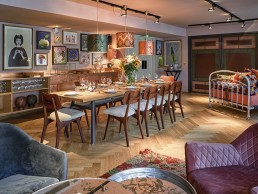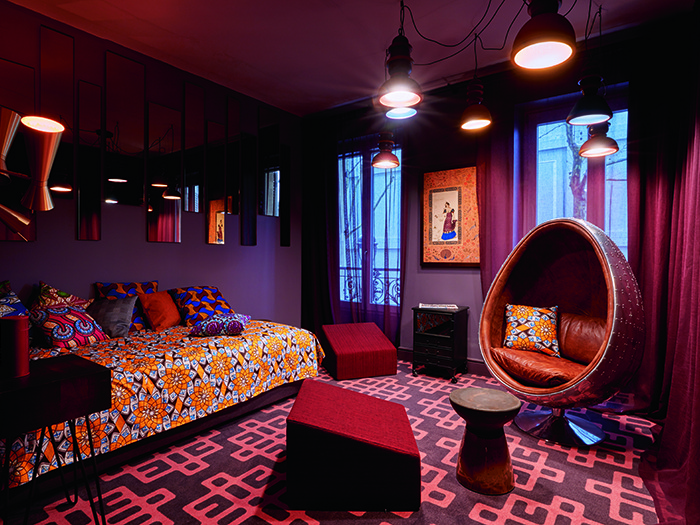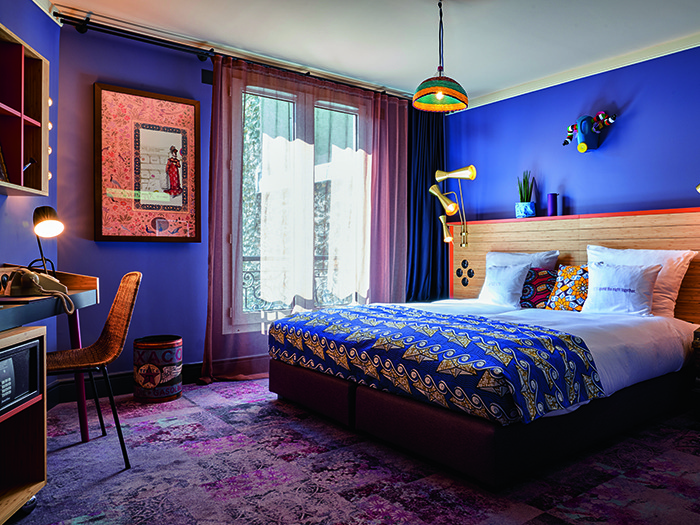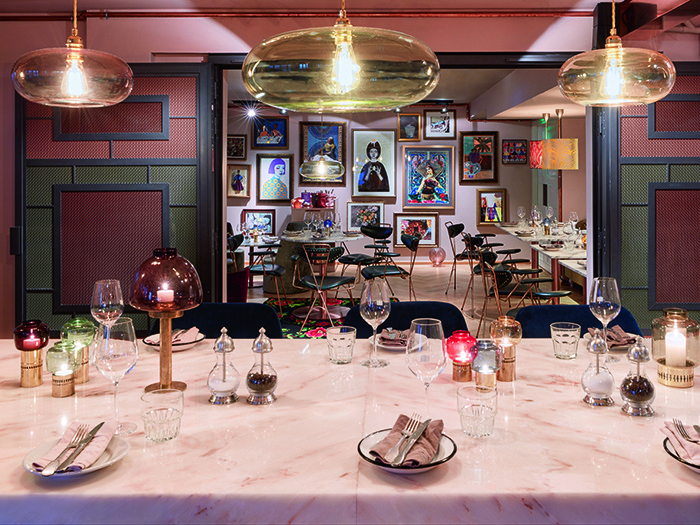
25hours Hotel, Paris
Design studio Dreimeta worked to turn the latest 25hours hotel at Paris Terminus Nord, into a declaration of love for the lively spirit of the surrounding district and its inhabitants.
The 25hours hotel group develops hotels whose designs alone are reason enough to travel. Guests with a cosmopolitan and urban flair appreciate and value the thirteen hotels that make it their mission to embody and reflect the essence of a city through creative design. Sparking imagination in their guests during an overnight stay, with highly individual, functional, beautiful and unique designs, the hotels are best described by their claim, ‘you know one, you know none’.
Each hotel is always different – but consistently great – created with both the guests and surrounding location in mind. As a result, since 2003, the four partners of 25hours have been met with great success and have strongly influenced the development of the hotel branch as a whole.
The 25hours Hotel Paris Terminus Nord, located opposite the central train station Gare du Nord, is a declaration of love for the lively spirit of this district and its inhabitants. Local heroes serve as inspiration, with design studio Dreimeta bringing the wild bustle of the 10th arrondissement directly into the house. A playful jumble of colourful street art-style murals decorate the various spaces and public areas, while the rooms are retreats in African and Asian inspired colours and shapes. The pulsing heart of the house is the restaurant Neni, with Israeli-Mediterranean cuisine and the Sape bar.

Having worked on 25hours hotels since the brand’s inception, Dreimeta is well versed in the hotel group’s design aesthetic and is usually involved at a very early stage – taking part in the conceptual process fairly early on. For this particular hotel, the team first came on board in 2016 with the hotel opening split into two phases – January 2019 and summer 2019.
Dreimeta Interior Designer Leandra Burke explains the design process to darc: “The starting point for our design was an inspiring tour through the surrounding neighbourhood, with its buzzing streets and multi-cultural population. It is a true melting pot of vastly different cultures from all over the world – people from Sri Lanka, Ivory Coast, Algeria, Senegal and Pakistan bring a vibrant spirit to the streets of the 10th arrondissement, straight to the doorstep of the hotel. The interior reflects these rich cultures and brings the flair of the lively streets into the hotel.”
One of the main challenges for the design team on this particular project, came about due to the nature of the building – a renovation project.
Burke explains how historic structures are always a challenge: “In terms of functionality, it was crucial to renovate the building to meet current fire safety regulations and escape route requirements, but also to update technical features to meet modern standards.
“Another area of design that proved challenging was the 237 rooms – they all have different layouts and by different, I mean really different. We had to come up with flexible / adaptable solutions in terms of the built-in furniture in order to give the rooms a very individual feel, while taking into account that costs didn’t spiral by having too many variations of furniture types.”
In addition to the 237 rooms, the hotel features a reception and snack kiosk on the ground floor, as well as a co-working area, a bar and restaurant on the first floor. Adjacent to the restaurant, two private dining rooms offer more exclusive areas to host parties or meetings.

“The public areas in particular have experienced some of the most notable changes,” continues Burke. “The entrance area, housing the lobby and reception, was opened up significantly and a spacious new stairway was built to connect the ground floor with the public areas on the first floor, leading guests to the bar and restaurant, as well as to the rooms.
“As this entire area is declared as one of the main escape routes of the building, one of the main challenges was to furnish and decorate the area in-line with the overall concept, while meeting the strict fire safety regulations.
“On top of redesigning the space to meet functional requirements for the operation of the hotel, it was important for the design team to incorporate the history of the building. During the early stages of the renovation, original ornate ceilings with elegant crown moulding were discovered and preserved, adding a great touch of the original spirit of the building to the rooms.”
The overall storyline of the hotel is the surrounding neighbourhood, with its eclectic mixture of different cultures. As such, it was important to the design team that elements chosen complemented the overall concept, or the specific concept of a certain space.
In terms of lighting, there wasn’t a specific brief given, but as Dreimeta has partnered with 25hours on a number of hotels, it is aware of the crucial role decorative lighting plays in all of the hotel group’s projects. Burke explains further: “They prefer a very cosy and warm atmosphere with particularly low dimming levels,” she says. “For us, as interior designers, decorative lighting is a very important element; different light sources add warmth and depth to a space and it’s definitely one of the factors of vital importance in whether someone feels at ease in a space or not.”
In the hotel bedrooms, Dreimeta chose pendants made out of recycled PET plastic bottles that combine traditional weaving techniques from different corners of the world, complementing the vibrant rooms.

“In some of the rooms we found ornate ceilings with crown mouldings and as we didn’t want to impede the ceilings with electrical wiring, we hung the pendants from the ceiling and instead of connecting them to a ceiling outlet, we equipped them with long colourful textile cables that were then connected to a socket next to the bed,” says Burke. “Further to this, we custom-designed bedside lamps that integrated a reading light – orientated downwards – and two light sources pointing towards the ceiling, to add more general light to the room. These were executed and supplied by Baulmann.”
Moving to the main public spaces, one of the main feature lights is a huge copper chandelier from Luxxu, positioned right after the entrance door, while moving to the bar, La Sape, (a movement of Congolese dandies, well-dressed men who appropriated and transformed European formal clothing) was decisive in determining the style. Both the Societe des Ambianceurs et des Personnes Elegantes (Sape) and African record labels have strong roots in the neighbourhoods around the Gare du Nord. Thus, the interior is also inspired by African music from the 1960s -1980s. Old album covers and art revolving around the Sape movement are on display; in keeping with this, the bar is masculine and elegant, embellished with patterned fabrics reminiscent of the Sapeurs’ suits and clothing.
“We custom-designed table lamps that are arranged in a row on top of the countertop,” says Burke. “These feature lamp shades from Baulmann, with various patterned fabrics – some African wax fabrics – also allude to the Sapeurs’ clothing.”
While the bar focuses on the male world, the restaurant is a tribute to women from a wide range of cultures. The colours in this area are softer and the art in the space features more feminine themes. “Cosy lounge chairs upholstered with velvet in pastel tones, pink marble and copper, paired with oak parquet flooring and vintage kilims with floral motifs are featured.
“We wanted the space to have an Asian feel, mixed with a Parisian boudoir atmosphere. As such, various glass lights in soft tones were combined with patterned textile lights from Ebb & Flow.”
Reflecting on the project, for Burke, the concept came to life just as the team had planned. “Our aim is to always translate the values of our clients into material and form, through which we provide them with a unique profile that is sound and reliable,” she says. “We are not architects or designers with a signature style that must be represented in every project; instead we produce and develop every project individually in order to find the best solutions for our clients, with the goal of creating spaces with identity and personality.
“Our approach is to add an emotional dimension to the room – with interior design that tells tales and inspires the senses. Nonetheless, functionality is always part of the concept and often leads to unexpected and creative design solutions.”



